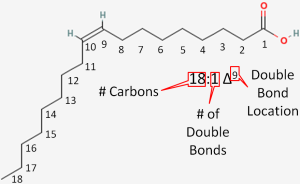Chemists, nutritionists, and lay-people describe fatty acids using different naming systems. Nutritionists focus much more on Omega and Common names.
There are three naming systems used for fatty acids:
- Delta nomenclature
- Omega nomenclature
- Common names
The Omega Nomenclature and common names are used more in the field of nutrition than the delta nomenclature when describing specific fatty acids.
Delta Nomenclature
Chemists use Delta Nomenclature, but nutritionists are more focused on the Omega system which focuses on the nutritional value of the fatty acid. For Delta Nomenclature one needs to know 3 things:
- Number of carbons in the fatty acid
- Number of double bonds
- Number of carbons from the carboxylic acid (alpha) end to the first carbon in the double bond(s)
Let’s consider the example in the figure below.
Figure: Delta Nomenclature

Fatty Acid with 18 carbons with a double bond at the ninth carbon atom. This is also an Omega 9 fatty acid which will be explained below.
- Number of carbons in the fatty acid = 18
- Number of double bonds = 1
- Number of carbons from the carboxylic acid end to the first carbon in the double bond = 9
Omega Nomenclature
The Omega Nomenclature is almost exactly the same as the Delta Nomenclature; the only difference is that carbons are counted from the methyl (omega) end instead of the carboxylic acid end, and the omega symbol is used instead of the delta symbol.
For Omega Nomenclature one needs to know 3 things:
- Number of carbons in the fatty acid
- Number of double bonds
- Number of carbons from the methyl end (aka Omega end) to the first carbon in the double bond closest to the methyl end
We will again consider the same fatty acid.
Figure: Omega Nomenclature
- Number of carbons in the fatty acid = 18
- Number of double bonds = 1
- Number of carbons from the methyl (aka omega) end to the first carbon in the double bond closest to the methyl end = 9
If it is a saturated fatty acid, then the omega nomenclature is not added to the end of the name. If it is an 18 carbon saturated fatty acid, then it would be named 18:0.
This is written as shown in figure 2.332. Instead of an omega prefix, the prefix n- (i.e. n-3) is also commonly used.
Common Names
The common names of fatty acids are something that, for the most part, have to be learned/memorized. The common name of the fatty acid we have been naming in this section is oleic acid.
The table below gives the common names and food sources of some common fatty acids.
Table: Common names of fatty acids[1]
| Omega Name | Common Name |
| 4:0 | Butyric Acid |
| 12:0 | Lauric Acid |
| 14:0 | Myristic Acid |
| 16:0 | Palmitic acid |
| 18:0 | Stearic Acid |
| 20:0 | Arachidic Acid |
| 24:0 | Lignoceric Acid |
| 18:1 (n-9) | Oleic Acid |
| 18:2 (n-6) | Linoleic Acid |
| 18:3 (n-3) | Alpha-linolenic Acid |
| 20:4 (n-6) | Arachidonic Acid |
| 20:5 (n-3) | Eicosapentanoic Acid |
| 22:6 (n-3) | Docosahexanoic Acid |
The NutritionData link below can help identify foods that are high in a specific fatty acid.
Food Sources of Fatty Acids
The figure below shows the fatty acid composition of certain oils and oil-based foods. As can be seen, most foods contain a mixture of fatty acids. Stick margarine is the only product in the figure that contains an appreciable amount of trans fatty acids. Corn, walnut, and soybean are rich sources of omega-6 polyunsaturated fatty acids while flax seed is fairly unique among plants in that it is a good source of omega-3 polyunsaturated fatty acids. Canola and olive oil are rich sources of monounsaturated fatty acids. Lard, palm oil, butter and coconut oil all contain a significant amount of saturated fatty acids.[2]

This chart shows saturated fat (Sat Fat), Monounsaturated fatty acids (MUFA), Polyunsaturated fatty acids (PUFA – Omega 3), Polyunsaturated fatty acids (PUFA – Omega 6), and Trans Fat in different foods.
